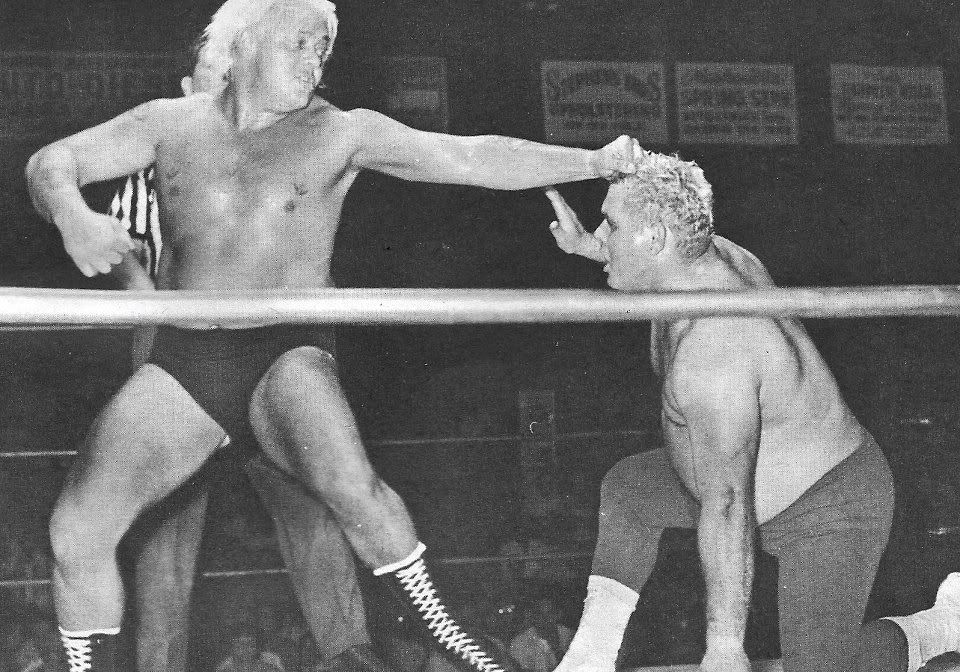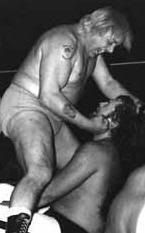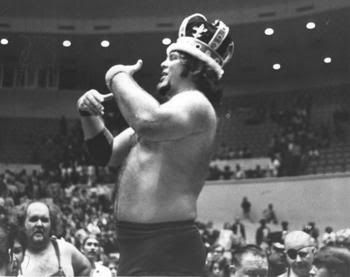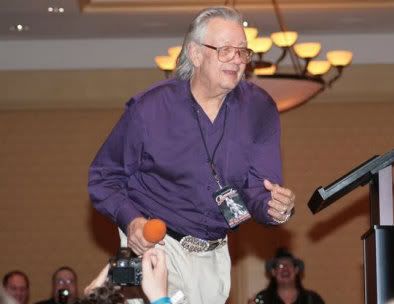A professional wrestling and sports column featuring opinions and coverage on the national and independent level.
Wednesday, April 18, 2012
Monday, April 16, 2012
WrestleForce Showcases Reunion of Raven's Flock at Spring Fling 2012
An independent wrestling show can sometimes be a tough sell without having either a "name" appear on the card from a national promotion or a great main event draw. Fortunately the newly formed WrestleForce promotion based out of Columbia, SC is providing both this Saturday, April 21 at The Loose Cockaboose sports bar and grill.
Although the backing force of burgeoning promotion wishes to remain anonymous, Jon Malus is very vocal about the presentation WrestleForce has in store for the Columbia wrestling fans.
"The overall reception was that Fall Brawl was a success. And that it was going to be a challenge to make Spring Fling just as appealing as Fall Brawl was," Malus said recently. Indeed, the Fall Brawl show that The Cockaboose showcased in October of last year was as good an independent wrestling show as any that has been performed in this state. The main draw of the show was a Battle Bowl style tag team tournament that would lead into a late night battle royal between the winners of each tag team match.
Spring Fling, however, is being built around not only an eight man tournament to crown the first ever WrestleForce Champion but also a War Games style tag match within the confines of a steel cage. On one side, "The Insane Lumberjack" Timer leads Jay Batista, Salem Sinner Sixx, and former ECW star CW Anderson against "The Juggernaut" Malus with WCW stars (and former Flock members) Raven and Lodi along with former ECW star Axl Rotten.
But plenty of other independent stars will be appearing at the event as well including another former Raven's Flock member, Sick Boy, as well as Michael Frehley, Hoss Hagood (who was the winner of the Fall Brawl event last year), BJ Hancock, Jesse Windham, and many more.
The tournament to crown the first ever WrestleForce Champion includes the likes of recent Resistance Pro Wrestling signees John Skyler and Steven Walters as well as Chase Stevens, Zack Salvation, Vordell Walker, Shane Williams, Caleb Konley, and a replacement to be named later for the injured Aden Chambers.
Of course, never forget the quintessential statement regarding a wrestling show: Card is always subject to change.
Spring Fling will begin at 3pm with a meet and greet with the wrestlers competing at the event at The Loose Cockaboose located at 936 S. Stadium Rd., Columbia, SC, 29201. Bell time for the event will be at 4:15pm. Advance tickets are currently on sale at Kelly's Deli & Pub and The Cockaboose for $5. Tickets purchased the day of the show will be $7.
Also scheduled to appear after the wrestling has finished are local bands Space Coke and Mommy's Little Monsters.
Again, if Fall Brawl is any indication, Spring Fling, under the banner of WrestleForce will be not only a fun wrestling show to attend but a great getaway on a Saturday afternoon in Columbia, SC.
You can follow WrestleForce on Facebook at www.facebook.com/WrestleForce as well as on Twitter @WrestleForce.
Read more here: http://events.thestate.com/columbia_sc/venues/show/370684-the-loose-cockaboose#storylink=cpy
Although the backing force of burgeoning promotion wishes to remain anonymous, Jon Malus is very vocal about the presentation WrestleForce has in store for the Columbia wrestling fans.
"The overall reception was that Fall Brawl was a success. And that it was going to be a challenge to make Spring Fling just as appealing as Fall Brawl was," Malus said recently. Indeed, the Fall Brawl show that The Cockaboose showcased in October of last year was as good an independent wrestling show as any that has been performed in this state. The main draw of the show was a Battle Bowl style tag team tournament that would lead into a late night battle royal between the winners of each tag team match.
Spring Fling, however, is being built around not only an eight man tournament to crown the first ever WrestleForce Champion but also a War Games style tag match within the confines of a steel cage. On one side, "The Insane Lumberjack" Timer leads Jay Batista, Salem Sinner Sixx, and former ECW star CW Anderson against "The Juggernaut" Malus with WCW stars (and former Flock members) Raven and Lodi along with former ECW star Axl Rotten.
But plenty of other independent stars will be appearing at the event as well including another former Raven's Flock member, Sick Boy, as well as Michael Frehley, Hoss Hagood (who was the winner of the Fall Brawl event last year), BJ Hancock, Jesse Windham, and many more.
The tournament to crown the first ever WrestleForce Champion includes the likes of recent Resistance Pro Wrestling signees John Skyler and Steven Walters as well as Chase Stevens, Zack Salvation, Vordell Walker, Shane Williams, Caleb Konley, and a replacement to be named later for the injured Aden Chambers.
Of course, never forget the quintessential statement regarding a wrestling show: Card is always subject to change.
Spring Fling will begin at 3pm with a meet and greet with the wrestlers competing at the event at The Loose Cockaboose located at 936 S. Stadium Rd., Columbia, SC, 29201. Bell time for the event will be at 4:15pm. Advance tickets are currently on sale at Kelly's Deli & Pub and The Cockaboose for $5. Tickets purchased the day of the show will be $7.
Also scheduled to appear after the wrestling has finished are local bands Space Coke and Mommy's Little Monsters.
Again, if Fall Brawl is any indication, Spring Fling, under the banner of WrestleForce will be not only a fun wrestling show to attend but a great getaway on a Saturday afternoon in Columbia, SC.
You can follow WrestleForce on Facebook at www.facebook.com/WrestleForce as well as on Twitter @WrestleForce.
Read more here: http://events.thestate.com/columbia_sc/venues/show/370684-the-loose-cockaboose#storylink=cpy
Wednesday, April 4, 2012
Going Broadway 04.03.12 All Comers: Bob Backlund's World Title Tour
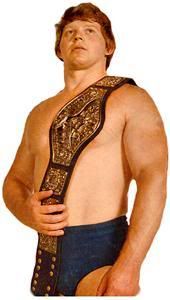
In April of 1977, Superstar Billy Graham rose to prominence in the WWWF when he defeated Bruno Sammartino to become the company's new World Champion. Unlike previous heels Ivan Koloff and Stan Stasiak who held the title for less than a month, Graham would tear through 1977 and into 1978, selling out Madison Square Garden and astounding 19 out of 20 times and eventually becoming the forerunner to eventual stars Jesse Ventura, Hulk Hogan, and many others.
But there was another star on the rise during this time.
At 27 years old, Bob Backlund debuted in the WWWF in 1977 and within only a few months found himself one of the top contenders to Graham's World Championship. The complete antithesis of Graham's Superstar character, Backlund wore classic wrestling trunks and boots to the ring and shied away from poses to show off his physique. He had a sort of Ron Howard-Opie look or, as he was eventually monikered, a Howdy Doody look, and became a blue collar hero to the wrestling fans in the vein of Sammartino or Morales before him. And just like those names previous, Backlund could more than back it up in the ring.
...
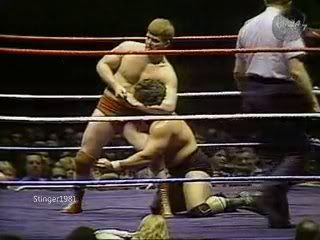
Born in Princeton, Minnesota in 1950, Backlund was a multi-sport prodigy growing up, but it was wrestling he ultimately settled upon, which paved the way to junior college success as well as NCAA honors at North Dakota State, where he won the Division II National Championship at the 191 pound weight class in 1971.
In 1973, Backlund moved up to professional wrestling when he joined the AWA. Despite having bulked up to 240 pounds, Backlund was still regarded as undersized for the heavyweight ranks but more than made up for any lack of size with his technical savvy in the ring, which instantly got him over with fans.
As a professional, he was trained by the famed Eddie Sharkey, who was the mentor to such future stars such as Jesse Ventura, Rick Rude, The Road Warriors, X-Pac, Jerry Lynn and many others. (Side note: Eddie Sharkey worked at a bar called Grandma B's, where the bouncing corps included both Road Warriors, Hawk and Animal, as well as Rick Rude. Imagine causing a ruckus in that place?)
Besides his work with AWA, Backlund began traveling throughout the country, working various NWA promotions in different regions. With various tag team partners, Backlund was able to accumulate many tag team championship reigns during this journeyman days. But his greatest accomplishment during this time was defeating Harley Race for the NWA Missouri Heavyweight Championship in April of 1976. It would not be the last time he would have a noteworthy bout with Race…
By late 1976, Backlund had dropped the Missouri title to Jack Brisco, and left the territory not long after to join Vincent J. McMahon and the WWWF.
…
Backlund and Graham had a series of memorable matches throughout 1977 and heading into 1978 with inconclusive results in each. Backlund would either suffer a count out loss or Graham would be the recipient of the count out loss. Either way, he was continuously falling short of finally toppling the dominant Graham and taking the WWWF Title.
On February 20, 1978 at Madison Square Garden, Backlund and Graham would clash again. Serving up a masterpiece performance like they had previously, the finish of this match, however, had Backlund executing his patented atomic drop on Graham and gaining a three count victory, despite the fact that Graham's leg was draped on the bottom rope (something the referee failed to see). Backlund was the new WWWF Champion. (Voted 1978 match of the year by Pro Wrestling Illustrated)
Backlund's victory was a return to the ultra baby face champion that Sammartino and Morales represented. But unlike his predecessors, Backlund was about to embark on an impressive and ambitious world title reign that included cross over, champion vs champion matches with multiple promotions.
Not even a week after defeating Graham, Backlund was slated to once again face his previous nemesis, Harley Race, who was the current NWA Heavyweight Champion. (To be fair, Graham competing against Race as well for both belts.) Their first encounter would go Broadway at the 60 minute mark, but they would face each other again at least three more times over Backlund's reign as WWWF champion and Race's reign as NWA Champion.
The promo and match below are from the September 22, 1980 bout between both men.
In March of 1979, Backlund took the WWWF Title to Toronto to face the AWA Champion, Nick Bockwinkel, who was the promotion's reigning champion for six years at that point. Bockwinkle, another very gifted mat wrestler, went toe to toe with Backlund for nearly 40 minutes before both men were counted out after battling outside of the ring.
Later in November of 1979, Backlund traveled to Japan to take part in what might be considered his most highly regarded series of matches with the great Antonio Inoki. A wrestling masterpiece in every sense of the word, the two grapplers traded advantages back and forth with an unlikely and controversial finish coming with Inoki getting the win after a belly to back suplex. The controversy stemmed from Backlund thinking he had just pinned Inoki after he landed the atomic drop. However, the referee did not count Inoki out, which left the distracted Backlund vulnerable to Inoki's finisher.
Backlund protested the finish, and a rematch was set for December 6, 1979, once again in Japan. The match was again a well executed affair, but this time it was Backlund who won the bout despite again controversy surrounding the finish because of outside interference from Tiger Jeet Singh. The WWF "President" Hisashi Shinma had the result thrown out, but Inoki, in turn, vacated the belt due to the circumstance. Backlund returned to the United States as WWF champion. The title change was never acknowledged, and some reports point to this being a total work and some point to it as being a screw job on Inoki because he supposedly vacated the title in order to have a follow up match in New York for the belt (which ended up being a match between Backlund and Bobby Duncum).
In 1982, Backlund once again was pressed into representing the WWF against the NWA with a bout against then champion Ric Flair, which was another contest that ended in a double count out at the Omni in Atlanta, Georgia.
From a wrestling fan's perspective nowadays, a unification match of titles between the WWWF/WWF, NWA, and AWA would surely never end in a definitive winner. Of course the result would be a push in some form, whether it is a time limit draw or a count out or a disqualification. The significance though of Backlund's World Title Tour was that it brought distinction to the WWF title, which was still needing validation as a prestigious championship.
Backlund held the WWF title for nearly six years when Vince McMahon made the decision that Hulk Hogan was going to be the new face of the company due to his undeniable charisma and massive commercial appeal. It's not surprising that Backlund was reluctant to drop the belt to Hogan due to his successor's lack of wrestling skills. This, therefore, set up the match between Backlund and The Iron Shiek on December 26, 1983 where Backlund famously never gave up despite being locked in the Camel Clutch. But it was his manager Arnold Skaaland who threw in the towel from Backlund's corner, forcing the referee to stop the match and declare The Sheik the new WWF champion. At least in his loss, Backlund could maintain he never actually submitted.
Three weeks later, Hogan leg dropped his way to the WWF Title and the rest for him and professional wrestling is history. Everything changed from there. Backlund, however, would only wrestle for the company for another year before leaving in 1984.
But eight years later, Backlund would return to the WWF, and looked like he hadn't skipped a beat. His entry into the 1993 Royal Rumble was testament to his incredible stamina as he lasted over an hour at age 43. But the Bob Backlund face character of the 70's and 80's didn't fit in this new generation of the WWF. In fact, even in the latter stages of his run in the 80's, the fans started to wain at his All American look and demeanor, frequently chanting "Howdy Doody" during his matches.
Backlund had refused a heel turn during the 80's, but took the character turn in 1994 and morphed into "Mr. Bob Backlund," a psychotic and sociopathic version of his former character, frequently demeaning the amorality of America had embraced and attacking other wrestlers with his Crossface Chicken Wing. (Jim Ross isn't a wrestler, but he received the same treatment as seen below. Don't know why the video repeats with no audio, though.)
Backlund's heel run produced many memorable, humorous moments of insanity, but it also produced one last great series of matches with Bret Hart. The famous "Towel Match" at Survivor Series in 1994 had a reverse deja vu moment when Hart's mother Helen threw in the towel as her son was locked in the Crossface Chicken Wing, giving the win to Backlund. The following Wrestlemania in 1995, they faced off again in an "I Quit" match, where Backlund famously, unintelligibly submitted to Hart's version of the Crossface Chicken Wing.
In between both matches, Backlund was once again WWF Champion (having won the belt as a result of his victory over Hart in the "Towel Match"), although his brief reign is more notorious for how long (or short) his defense was against Diesel, when he was power bombed and pinned in eight seconds.
Backlund ultimately left the WWF in 1997 again, but would resurface a couple more times over the years. In 2000, he reappeared as Kurt Angle's manager and passed down his Crossface Chicken Wing to the rising star. He would also make a guest appearance at the Monday Night Raw 15th Anniversary show as part of a battle royal and during the same year work briefly for TNA Wrestling.
But Backlund's legacy ultimately rests during that six year run he had as WWWF/WWF champion. While the groundwork had been laid by Sammartino and others, Backlund's reign maintained and ramped up the WWF heading into the era where wrestling would explode into a national phenomenon. Sadly, like Sammartino, Backlund is not in the company's hall of fame, refusing supposedly based upon the notion he thinks he can be the World Champion again.
I wouldn't doubt for a second that Backlund could still hold his own in a wrestling match with anyone in the company today at 62 years old. In fact, what an amazing and gratifying image it would be for old school wrestling fans to see Backlund lock John Cena in that Crossface Chickenwing right in the center of the ring.
That's Mr. Bob Backlund to you, John Cena!
Subscribe to:
Posts (Atom)
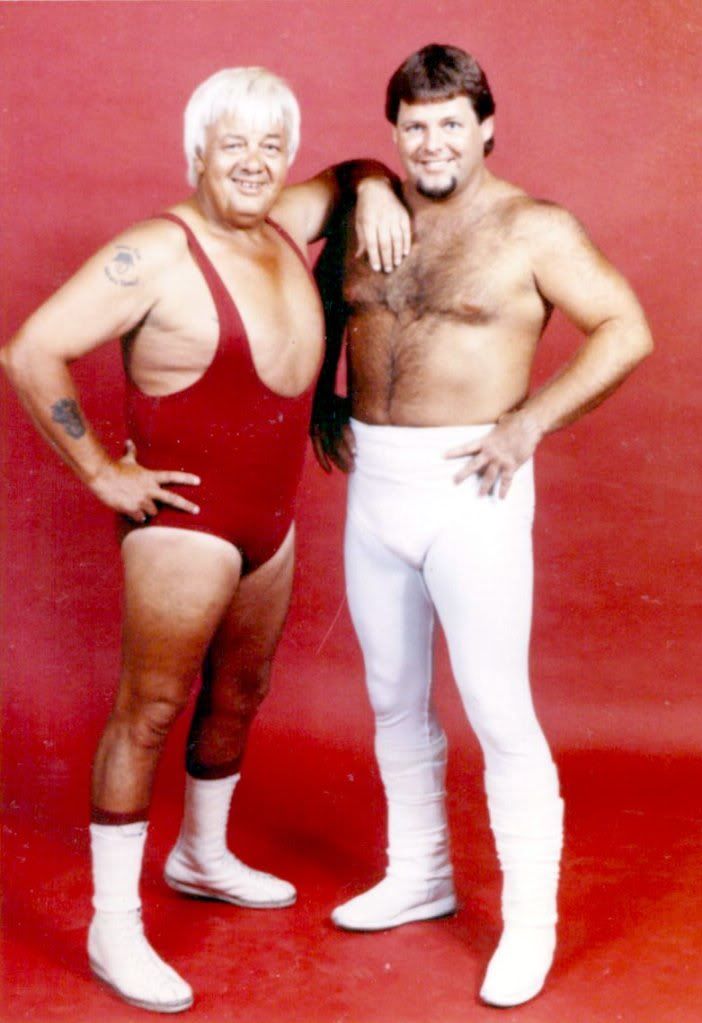 By 1974, a new generation of wrestlers were beginning to take the Memphis territory over and carry on the legacy of previous giants such as Sputnik Monroe and Billy Wicks. With the television broadcast becoming a bigger tool in showcasing the talents of this next generation to more and more fans in the region, so did the action and the feuds become equally hotter and larger. The perfect recipe and the perfect storm for a young artist/disc jockey turned wrester to emerge as not only the next face of the Memphis wrestling promotion but also as a nationally recognized star in the business.
By 1974, a new generation of wrestlers were beginning to take the Memphis territory over and carry on the legacy of previous giants such as Sputnik Monroe and Billy Wicks. With the television broadcast becoming a bigger tool in showcasing the talents of this next generation to more and more fans in the region, so did the action and the feuds become equally hotter and larger. The perfect recipe and the perfect storm for a young artist/disc jockey turned wrester to emerge as not only the next face of the Memphis wrestling promotion but also as a nationally recognized star in the business.